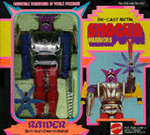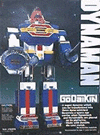|
ToyboxDX
Guide to Chogokin and Popinika
 Popy's
legendary diecast toys are a ubiquitous
presence on the Japanese toy scene. If
you've ever bought a Shogun Warrior, you've
bought a Popy toy. If you've ever bought
a Godaikin, you've bought a Popy toy.
If you've ever bought ANY Japanese diecast
robot toy from the 1970s, well, you might
as well have been buying a Popy toy. Popy's
Chogokin and Popinika diecast toys set
the standard that everyone else tried
to imitate. Popy's
legendary diecast toys are a ubiquitous
presence on the Japanese toy scene. If
you've ever bought a Shogun Warrior, you've
bought a Popy toy. If you've ever bought
a Godaikin, you've bought a Popy toy.
If you've ever bought ANY Japanese diecast
robot toy from the 1970s, well, you might
as well have been buying a Popy toy. Popy's
Chogokin and Popinika diecast toys set
the standard that everyone else tried
to imitate.
Legendary,
defunct Japanese toymaker Popy launched
the Chogokin
series in 1973. Much like the words "Xerox"
and "Band-Aid," the brand name
has become a generic catchall term for
robot figures molded out of diecast metal.
Indeed, the very word itself, a semi-fictional
term taken from the animated series Mazinger
Z, means "super-alloy." Much
to the surprise of many collectors, however,
Chogokin toys weren't the first items
Popy created and sold.
World-famous
toy company Bandai founded Popy in July
1971 as a spin-off devoted to the creation
of toys based on characters licensed from
films, television, and comic books. Popy
scored a grand-slam hit the very next
year with their innovative Kamen Rider
Henshin Belt, a vinyl-and-plastic replica
of the one worn by the hero in the popular
Kamen Rider television show.
 As
popular as the belt became, however, the
major reason for Popy's success was a
gamble on a material that hadn't been
widely used for toys up until that point:
diecast zinc-alloy. The British company
Dinky had tried selling diecast space
vehicles and cars in Japan, but had suffered
sluggish sales due to the high price of
the imported toys. It was still an open-ended
question as to if Japanese children raised
on a diet of tin and vinyl would take
to solid metal, but Popy took the chance.
In April of 1972, Popy released the "Mini-Mini
Cyclone," a palm-sized metal and
plastic motorcycle based on Kamen As
popular as the belt became, however, the
major reason for Popy's success was a
gamble on a material that hadn't been
widely used for toys up until that point:
diecast zinc-alloy. The British company
Dinky had tried selling diecast space
vehicles and cars in Japan, but had suffered
sluggish sales due to the high price of
the imported toys. It was still an open-ended
question as to if Japanese children raised
on a diet of tin and vinyl would take
to solid metal, but Popy took the chance.
In April of 1972, Popy released the "Mini-Mini
Cyclone," a palm-sized metal and
plastic motorcycle based on Kamen  Rider's
favorite vehicle. The Cyclone proved as
successful as the belt and firmly established
a market for diecast character toys. Rider's
favorite vehicle. The Cyclone proved as
successful as the belt and firmly established
a market for diecast character toys.
Building
on the strength of their previous successes,
Popy obtained the rights to a new character,
an animated giant robot known as Mazinger
Z. Realizing Mazinger Z's charm as a towering
robot of justice, Popy released the first
piece in what would become a long running
series of large-scale toys: the Jumbo
Machinder Mazinger Z. Standing at two
feet tall and constructed from a nearly
indestructible material called polyethylene,
the Mazinger Z would rack up sales of
an astounding 400,000 units within five
months.
 It
was probably only a matter of time before
someone at Popy put two and two together,
combining the best aspects of two of their
most popular toy lines. In February of
1974, Bandai unveiled what would become
a near-universally regarded classic of
toy design, the Chogokin Mazinger Z. Molded
from nearly solid diecast metal and featuring
spring-loaded shooting fists, the five-inch-high
figure would set a new standard for character
toys. Although not as large as its Jumbo
counterpart, the diecast Mazinger Z featured
a satisfying metallic heft. And perhaps
even more importantly, Popy sold it as
a "Chogokin" toy -- that is,
a toy that was made from the exact same
"super alloy" as the robot in
the animated series. Children couldn't
get enough, and an entirely new concept
was born. It
was probably only a matter of time before
someone at Popy put two and two together,
combining the best aspects of two of their
most popular toy lines. In February of
1974, Bandai unveiled what would become
a near-universally regarded classic of
toy design, the Chogokin Mazinger Z. Molded
from nearly solid diecast metal and featuring
spring-loaded shooting fists, the five-inch-high
figure would set a new standard for character
toys. Although not as large as its Jumbo
counterpart, the diecast Mazinger Z featured
a satisfying metallic heft. And perhaps
even more importantly, Popy sold it as
a "Chogokin" toy -- that is,
a toy that was made from the exact same
"super alloy" as the robot in
the animated series. Children couldn't
get enough, and an entirely new concept
was born.
 Popy
reigned as the undisputed king of the
Japanese toy scene throughout the 1970s.
Their Chogokin diecast robots and Mini-Mini
(later to become "Popinika")
diecast vehicles proved so popular in
Japan that American toy firm Mattel imported
and repackaged many of them as "Shogun
Warriors." Parent company Bandai
would get in on the act as well, repackaging
the Deluxe Chogokin pieces as "Godaikin"
for resale in America in the early 1980s.
Other Japanese companies -- Takatoku,
Clover, Takemi, Bullmark, and Nakajima,
among many others -- tried to imitate
Popy's diecast paradigm with varying degrees
of success. Very few managed to reach
or maintain the level of quality maintained
by Popy's crack team of toy engineers. Popy
reigned as the undisputed king of the
Japanese toy scene throughout the 1970s.
Their Chogokin diecast robots and Mini-Mini
(later to become "Popinika")
diecast vehicles proved so popular in
Japan that American toy firm Mattel imported
and repackaged many of them as "Shogun
Warriors." Parent company Bandai
would get in on the act as well, repackaging
the Deluxe Chogokin pieces as "Godaikin"
for resale in America in the early 1980s.
Other Japanese companies -- Takatoku,
Clover, Takemi, Bullmark, and Nakajima,
among many others -- tried to imitate
Popy's diecast paradigm with varying degrees
of success. Very few managed to reach
or maintain the level of quality maintained
by Popy's crack team of toy engineers.
 All
good things come to an end, however. Children's
ever-changing tastes led to decreasing
sales of diecast robots towards the end
of the 1970s, and by March of 1983 Popy
found itself re-absorbed into parent company
Bandai. Popy's efforts had legitimized
and validated the character-toy industry;
the influence of their many innovations
can be felt in Japan and across the world
even today. And while Popy may be gone,
the brand they created endures. Bandai
has continued using the Chogokin name
near continuously since Popy's demise.
In 1997, they unveiled an all-new series
of toys, dubbed "Soul of Chogokin,"
to snare nostalgic adult collectors of
Popy's toys of old. All
good things come to an end, however. Children's
ever-changing tastes led to decreasing
sales of diecast robots towards the end
of the 1970s, and by March of 1983 Popy
found itself re-absorbed into parent company
Bandai. Popy's efforts had legitimized
and validated the character-toy industry;
the influence of their many innovations
can be felt in Japan and across the world
even today. And while Popy may be gone,
the brand they created endures. Bandai
has continued using the Chogokin name
near continuously since Popy's demise.
In 1997, they unveiled an all-new series
of toys, dubbed "Soul of Chogokin,"
to snare nostalgic adult collectors of
Popy's toys of old.
|
![[Alen Yen's ToyboxDX]](images/smlogo.gif)
